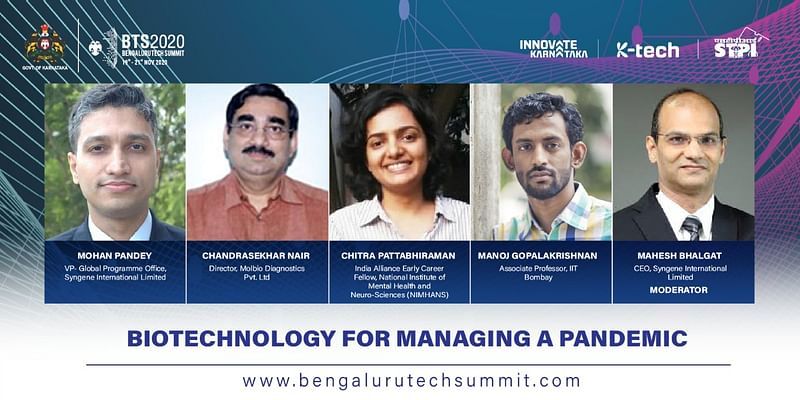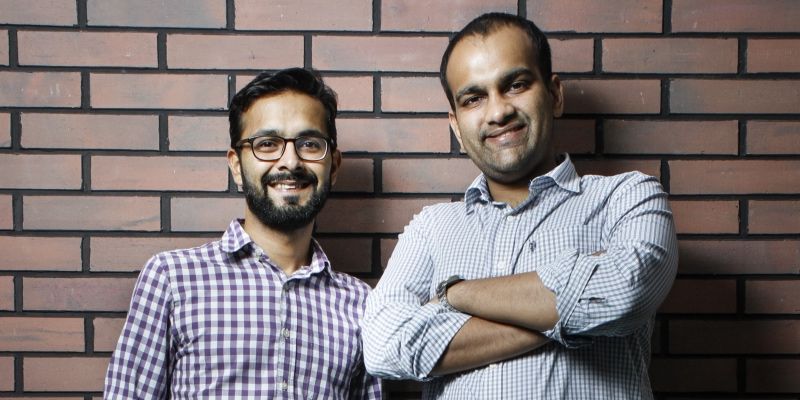How these innovative biotech solutions helped India shore up efforts to manage the pandemic
Here are some key takeaways from the panellists’ talk at Bengaluru Tech Summit 2020 on how these innovative approaches helped in the management of the COVID-19 pandemic.
From testing, tracing, containment, to overall pandemic management, technology has played a leading role in buoying up public health efforts during the COVID-19 outbreak. On Day 2 of the Bengaluru Tech Summit 2020, an insightful panel discussion on Biotechnology for Managing a Pandemic, shed more light on this topic and highlighted important instances where the power of data and technology were leveraged to create impactful solutions.
Experts on the panel included Mohan Pandey, VP- Global Programme Office, Syngene International Limited; Dr Chandrasekhar Nair, Founder-Director, Bigtec Labs and CTO, Molbio Diagnostics Pvt Ltd; Dr Chitra Pattabhiraman, India Alliance Early Career Fellow, NIMHANS; and Dr Manoj Gopalakrishnan, Associate Professor, IIT Bombay. The panel was moderated by Dr Mahesh Bhalgat, CEO, Syngene International Limited.
While stressing on the need to enable the Indian ecosystem to become self-reliant, some common themes that emerged from the discussion included the need for convergence of technologies, a need to break silos and facilitate open data sharing, and more collaboration across industry, academia and disciplines.
Here are some key takeaways from the panellists’ talk on how these innovative approaches helped in the management of the COVID-19 pandemic:
Mohan Pandey - Proactive testing
Dr Pandey kicked off the discussion by sharing Syngene’s approach to proactive testing. “When the pandemic broke out, everybody was overwhelmed. But realisation set in very quickly that cases will increase. We asked ourselves: how can we manage it in a way so that we flatten the curve? So, testing became a fulcrum of this entire paradigm,” he said.
Syngene had immediately implemented a system of continuous monitoring on its own campus, he shared. “During the first 21-day lockdown, we managed to contain the kind of spread that would have happened otherwise. In Bengaluru, the level of our testing and tracking was phenomenal. We had time to actively set up countermeasures, share information and improve awareness. But in late June and early July, cases around Bengaluru spiked significantly. We realised we needed to do more.”
At the same time, he came across a paper hypothesising that testing actually helps in controlling the outcome of the pandemic. It offered strong evidence that if there is more testing, then there is less mortality. “When there is a risk that cases are going to go up, we need to do testing. But we also need a more holistic approach for ourselves and for the community.”
So Syngene set up a testing lab where they tested more than 55,000 samples for free across communities. Dr Pandey added that they were not restricting themselves to only testing for infection, but also focusing on immune response antibody testing, for which they have launched a kit in the market.
“In response to the surge in cases around us, we decided to implement a proactive testing programme. The evidence is that if we adopt proactive testing, with a regular frequency, we can see much better control of the pandemic in the population.”
Dr Chandra Shekar Nair– Global point-of-care platform
Molbio Diagnostics’s Truelab Real Time quantitative micro PCR system is a global point-of-care platform used for molecular diagnostics that was 20 years in the making, and used even before the pandemic. The platform can test 23-odd diseases. “Our solution is easy to use, requires minimally trained people. It’s battery-operated, and does not depend on electricity. It does not require a cold chain. It basically democratises access to molecular tests,” Dr Nair said. The platform is versatile and can be used to test various kinds of samples, right from sputum samples for TB, to swab samples, stool samples, as well as plasma samples.
Each device comes with a SIM card slot and enables automatic reporting, auto monitoring, and has extremely high uptime. The platform is currently being used in 32 countries. .
“During the COVID-19 pandemic, we had an order to deploy 5,500 devices and conduct 5.9 million tests across the country, of which we have deployed over 1,000 so far. The devices helped run ICMR-approved COVID-19 tests. In addition to this, we have deployed about 2,000 devices, and nearly five million tests have been conducted on our platform so far.”
Dr Chitra Pattabhiraman — Genomic analysis of the spread of COVID 19 in Karnataka
“In the early part of the pandemic, we did a study on how the virus entered Karnataka? How did it spread? How did it change? Bengaluru was in a reasonably good state of containment at that point. We had a total of 1,578 cases in the entire state. We found that they were showing lineages from China. We also saw that there was no difference in the way that asymptomatic and symptomatic people were distributed across all these lineages,“ he said.
Dr Pattabhiraman and her colleagues conducted a cluster analysis, and as part of the study, contact tracing was done across the state for every person who was tested positive for COVID-19. They found that usually asymptomatic people tended to be in the centre of clusters while symptomatic people had fewer connections. At this point during the pandemic, they found that most of the clusters were locally contained, within a single district.
This helped them understand where to focus attention. “We linked epidemiological data with genomic data. The immediate release of data really helped in outbreak response visualisations for us to easily understand what was going on. We think that integrating such an approach in real-time into public health measures is essential for an effective outbreak response. This illustrates the power of technology and the power of data analysis to really help us understand what strategies to apply to contain pandemics. This is certainly something that's not just beneficial for COVID-19, but will also help us manage pandemics in the future.”
Dr Manoj Gopalakrishnan — Tapestry pooling approach
“The pandemic led to enormous economic distress. We had been asked to make an impossible trade off – between economic distress and health risks. The truth is, we don’t want either. We want a silver bullet, something that will minimise economic distress and will minimise the health stress. Of course, a vaccine could be one silver bullet. But that’s a work in progress and we don’t know when it will be ready and how effective it will be.”
At present, increased testing is a better option. There is a need for affordable, scalable frequent and scalable testing which offers fast and accurate results, and is built on proven technologies that can be trusted.
“The problem is that traditional testing is like trying to find a needle in a haystack. It’s a very slow and linear process.”
In contrast, the tapestry pooling method of testing developed by IIT –Bombay uses compressed sensing algorithms to test more patients with fewer trials and with accuracy. Tapestry pooling can be used to test a significantly greater number of people as compared to traditional PCR sampling.
“It offers 20 results per test in a single round, is fast, accurate, easy-to-use, and has been validated on more than 3,000 samples,” Dr Gopalkrishnan said, adding that the solution has received recognition and acclaim from across the world.
Edited by Kanishk Singh








![[Funding alert] Prescinto raises $3.5 M in seed round led by Venture Catalyts and Inflection Point Ventures](https://images.yourstory.com/cs/2/11718bd02d6d11e9aa979329348d4c3e/Imagewf2p-1607509774638.jpg)


![[Funding alert] Swiggy raises $43M more for Series I round from existing, new investors](https://images.yourstory.com/cs/2/f08163002d6c11e9aa979329348d4c3e/Swiggyimage1576503976120png)